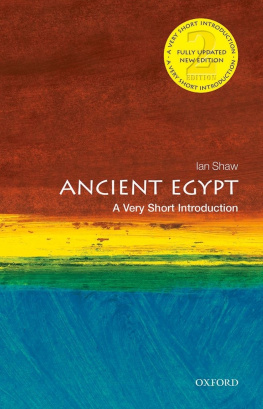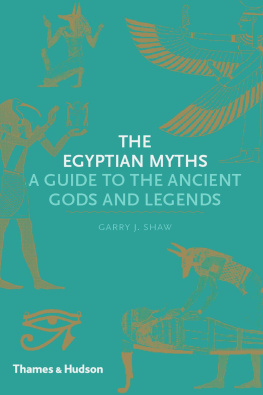



About the Author
Garry J. Shaw is an Egyptologist and travel writer who regularly writes for the Art Newspaper and has contributed to Apollo Magazine, History Today, Current World Archaeology and Timeless Travels. He is the author of The Egyptian Myths: A Guide to the Ancient Gods and Legends, also published by Thames & Hudson.
Other titles of interest published by
Thames & Hudson include:
The Egyptian Myths: A Guide to the Ancient Gods and Legends
Garry J. Shaw
Lives of the Ancient Egyptians
Toby Wilkinson
Ancient Egyptian Magic
Christina Riggs
Be the first to know about our new releases,
exclusive content and author events by visiting
www.thamesandhudson.com
www.thamesandhudsonusa.com
www.thamesandhudson.com.au
CONTENTS
To the memory of Lo-Paul Patenaude (19392020), a man who had a book collection to rival the Great Library of Alexandria.

You close your eyes and imagine the journey ahead. All of Egypt with its ancient myths and legends, gods, temples and tombs lies between you, newly arrived in Aswan, and Alexandria, 850 kilometres (530 miles) to the north. In your mind, you become the falcon god Horus, flying high over the Nile. Your wings catch the wind. You can see far. Look! Over in the distance. That hill is where the sun god defeated the followers of the chaos snake Apophis. The blood of Bastet created that peculiarly coloured rock. Those mounds are the tombs of the most ancient gods. Every stone, hill, temple and town that you pass as you fly over the land has a meaning, tied to the actions of divine forces. The Niles eternal journey north, cutting its channel through the harsh desert over millions of years, created this landscape. Its water feeds the fields that flank its route. From the rocky bends of the great river in the south, where the Nile flood was believed to erupt into the world from the infinite waters surrounding creation, northwards to Memphis, where it fans out to create the marshy Delta, Egypt is a land of mythology.

A map of Egypt made after the Prussian expedition of the 1840s, led by German Egyptologist Karl Richard Lepsius. Our journey will take us from Aswan, near the bottom of the map, to Alexandria in the north-west Delta.
Starring in these myths were the hundreds of divinities that comprised Egypts pantheon, beings that the Egyptians called netjeru. On the whole, these were gods with jobs, important roles in the cosmos: Osiris was responsible for processes of regeneration; Re was the sun at its most powerful; Ptah was the creative mind; and so on. These gods had many manifestations, but they werent everywhere at once. They were powerful, but only within their own areas of influence. They could travel freely throughout creation, but not beyond its limits. They were long-lived, but not immortal. They knew more than you and me, but they didnt know everything. They had human emotions, and human flaws. These powerful forces at work in the Egyptian world could be dangerous or helpful. They were ever changing, ever present and, to the Egyptians, very real.
Egypts temples were called mansions of the gods. These were exclusive places, where priests, literally the gods servants, made offerings to please those divinities who had cosmic responsibilities. These gods lived in the sky, their true forms like blinding, earth-shaking light always distant. But they sent down their manifestations to inhabit the statues crafted in their names. In this way, they could smell the sweet incense burning before them; suck the energy from food and drink left in their sanctuaries; feel the freshly washed linens wrapped around their bodies each day. This is what kept them happy. The priests actions kept the world turning, ensuring the annual flood and harvest and keeping Egypt in the gods favour. In order to do this successfully, they had to perform the correct rituals, the correct way, every day. To the Egyptians, this was not a belief system, for belief implies the existence of options. This was simply the way the world worked. The gods were a demanding bunch.
But to most people, in their day-to-day lives, the most influential deity wasnt the most important or powerful god in the pantheon. Re had a key role in creation, and was involved in running the cosmos, but when it came to your crops or illness, he had little interest. You wouldnt call the local mayor if your fridge broke down; they might have a lot of power, but their interest in your fridge is limited. Its the same with the Egyptian gods. Yes, Re might be able to help you with your field or your ailments, but realistically, he has better things to do. The oldest or most powerful god is not always the first port of call.
Rather than worrying about Res opinion of them while he went about his business in the cosmos, most people were more concerned about demons and ghosts. Demons inhabited the dark realm of the Duat, a place that was sometimes beneath the ground, sometimes in the sky. Such beings could escape this place through caves and bodies of water to terrorize the living, bringing sickness and disease. Ghosts, too, walked the earth, and could enter peoples homes, in a threatening or helpful capacity, depending on their mood. But it wasnt all bleak. Popular household gods also had a particular influence on daily life, such as Bes and Taweret, who looked after women and children, or Renenutet, who was responsible for the harvest. And the ancestors were never far from peoples minds, because they had a direct line to the gods.
All of these beings great or small were as much a part of Egypts environment as the desert, fields, cities, towns, villages and temples. The Egyptians knew they were all around us, all the time. The supernatural permeated every aspect of life and death. Myths, told around campfires, spread through literature or kept in temple libraries, explained this world through the actions of gods and the invisible. They brought order and understanding to the chaos of life, and comfort in hard times. Myths are more than stories; they are a reflection of us, representing a universal human need to make sense of reality.
Assembling Egyptian myths: our sources
How do we know any of this, you might be asking? The short answer is: with difficulty. Many problems face anyone attempting to reassemble the myths of ancient Egypt. There was no single source that gathered all the myths together no holy book of Egyptian religion. Myths are found in a variety of places, from temple and tomb walls to magic spells, but these often dont include all the details wed need to reconstruct the myth. Rather, we tend to find allusions to the myths, their meaning clear to readers or listeners who were already aware of the broader story. Episodes in the myths were also omitted for religious reasons. Art and texts were believed to have the power to magically bring whatever was represented or described into being. So, because temples and tombs were sacred spaces, requiring any inscription or carving to exhibit the perfection of divine order (
Next page
















